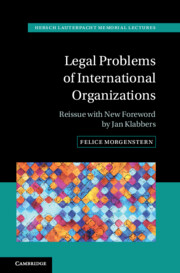Book contents
- Legal Problems of International Organizations
- Recent books in the Hersch Lauterpacht Memorial Lecture Series
- Legal Problems of International Organizations
- Copyright page
- Contents
- Foreword
- Preface
- Abbreviations
- Abbreviations of Organizations
- Table of Cases
- Introduction
- 1 The Legal Environment
- 2 Participation in International Organizations: Representation and Representativity
- 3 The Establishment of Standards of Conduct by International Organizations
- Conclusion
- Index
3 - The Establishment of Standards of Conduct by International Organizations
Published online by Cambridge University Press: 15 February 2024
- Legal Problems of International Organizations
- Recent books in the Hersch Lauterpacht Memorial Lecture Series
- Legal Problems of International Organizations
- Copyright page
- Contents
- Foreword
- Preface
- Abbreviations
- Abbreviations of Organizations
- Table of Cases
- Introduction
- 1 The Legal Environment
- 2 Participation in International Organizations: Representation and Representativity
- 3 The Establishment of Standards of Conduct by International Organizations
- Conclusion
- Index
Summary
The functions of many international organizations include the establishment of standards of conduct for purposes other than the internal functioning of the organization. With the major exception of the European Communities — which are so different that they have to be left out of account here — the organizations in question do not have legislative authority in the sense of having the power to make the standards legally binding on all addressees. The powers of organizations like I.C.A.O., W.H.O. and W.M.O. to make technical regulations,1 or of organizations like O.E.C.D, or the North-East Atlantic Fisheries Commission to take decisions, come closest to such authority; however, even these powers are accompanied by qualifications — the possibility of refusal by opting out or by notification of inability to comply; the requirement of unanimity; or the recognized need for Members to meet national constitutional requirements before complying — which ensure, in effect, that no State is bound against its will. It is thus appropriate to apply to the entire subject a statement originally made with respect to one of its features, namely that “the great debate of State sovereignty versus world community pervades every aspect of it”.2
- Type
- Chapter
- Information
- Legal Problems of International OrganizationsReissue with New Foreword by Jan Klabbers, pp. 95 - 139Publisher: Cambridge University PressPrint publication year: 2024



